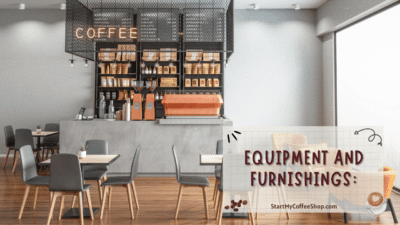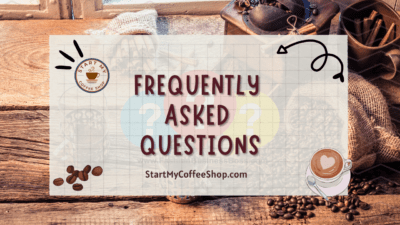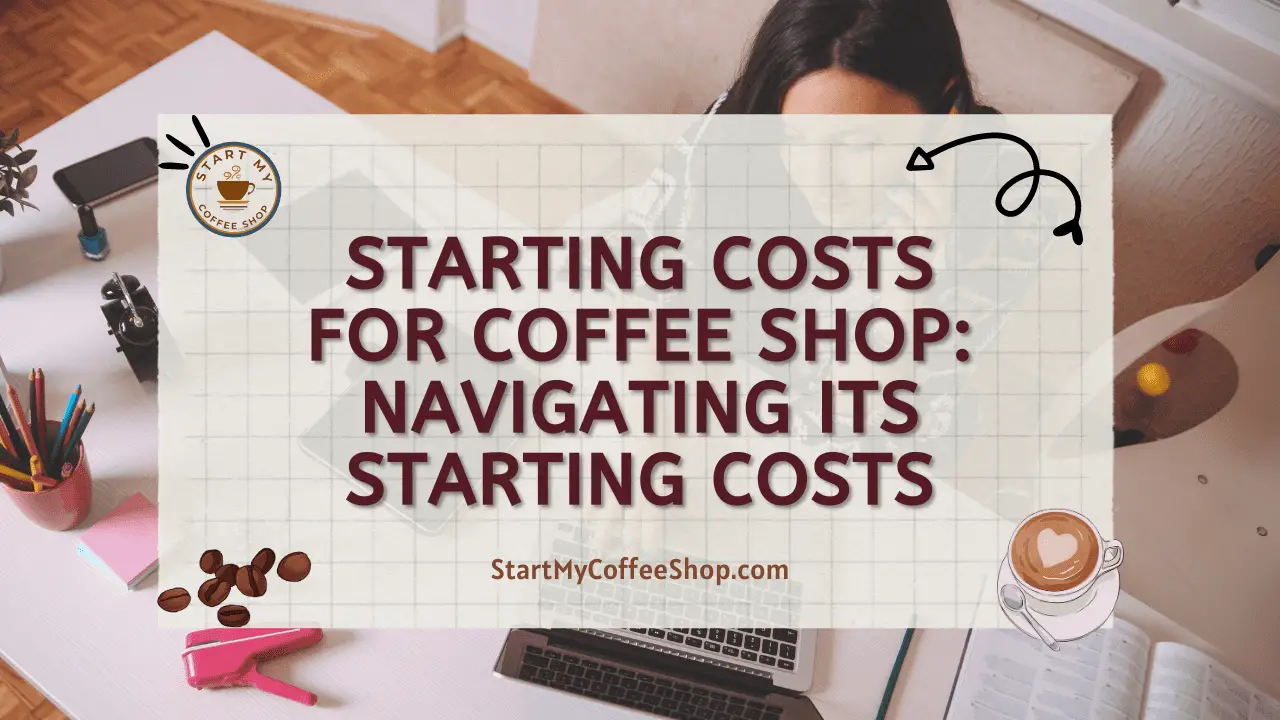Dreaming of opening your cozy coffee shop? Picture the aroma of freshly ground beans, the warm ambiance, and the joy of serving delightful brews to eager customers. However, before embarking on this caffeinated adventure, it’s crucial to understand the starting costs associated with opening a coffee shop.
The average cost of opening a coffee shop typically ranges from $80,000 to $300,000. However, the exact cost can vary depending on factors such as location, size, equipment, renovations, permits, licenses, inventory, marketing, and staffing.
In this article, I will delve into the various expenses you can expect, ensuring you are well-prepared to brew greatness from day one.
1. Location:
The location of your coffee shop plays a pivotal role in determining the starting costs involved. Prime locations in bustling city centers or trendy neighborhoods often come with a higher price tag due to their high demand. When considering the location, it is essential to factor in expenses such as rent, lease deposits, and potential renovations required to create an inviting and cozy ambiance for your customers.
Rent can be a significant portion of your budget, especially in sought-after areas. Landlords may require lease deposits, which can be a substantial upfront expense. Additionally, transforming the space into a welcoming coffee haven may involve renovations, such as installing plumbing, electrical work, or designing a comfortable seating area. These renovations can add to the initial costs but are crucial for creating an atmosphere that attracts customers.
Conducting thorough research and weighing the pros and cons of different locations can help you find a balance between the ideal setting and affordability. Carefully considering the associated costs of the location will allow you to plan your budget effectively and make informed decisions to set your coffee shop on the path to progress.
2. Equipment and Furnishings:
To craft that perfect cup of java, investing in the right equipment is crucial. Key items for a coffee shop include espresso machines, grinders, brewers, blenders, refrigeration units, and POS (Point of Sale) systems. These are the backbone of your operation, ensuring you can deliver consistent and high-quality beverages to your customers. It is advisable to opt for quality equipment to ensure durability and minimize maintenance costs in the long run.

In addition to the core equipment, it’s important to consider the cost of furniture, fixtures, lighting, and interior decor. Your coffee shop’s atmosphere plays a significant role in attracting and retaining customers. Comfortable seating, aesthetically pleasing decor, and appropriate lighting all contribute to creating an inviting ambiance. While it’s important to strike a balance between cost and quality, investing in the right furnishings and decor can enhance the overall customer experience and help differentiate your coffee shop from competitors.
When budgeting for equipment and furnishings, consider the size of your space and the capacity you aim to serve. Ensure you have the necessary equipment to handle peak hours efficiently without compromising on quality. Conduct thorough research, compare prices from different suppliers, and seek recommendations from industry professionals to make informed decisions about the equipment and furnishings that best suit your specific needs and budget.
By investing wisely in equipment and creating an inviting atmosphere through well-chosen furnishings and decor, you set the stage for a memorable coffee experience that keeps customers coming back for more.
Read more about Operation Costs for Opening a Coffee Shop: An Insider’s Guide to Operation Costs
3. Permits, Licenses, and Legal Requirements:
Running a coffee shop requires careful navigation through a maze of permits and licenses. Compliance with health department regulations, fire safety codes, and local zoning ordinances is essential to operate legally and safely. Understanding the costs associated with permits, licenses, inspections, and legal consultations is crucial for a smooth and lawful operation.
First and foremost, you need to ensure that your coffee shop meets health department standards. This may involve obtaining permits for food handling, food preparation, and maintaining cleanliness and sanitation. Additionally, fire safety codes must be adhered to, which may necessitate installing fire extinguishers, smoke detectors, and emergency exits.
Local zoning ordinances dictate the permissible land use for your coffee shop’s location. It’s important to check if your chosen space is zoned for commercial activities or if there are any special restrictions in place. Acquiring the necessary permits and licenses for your specific location is vital to avoid penalties or legal issues.
Bear in mind that acquiring permits and licenses often incur fees, which can vary depending on the jurisdiction. There may also be costs associated with inspections, as authorities may assess compliance before granting or renewing permits. Legal consultations can help ensure you have a thorough understanding of the regulations and assist with the application process.
By diligently following the necessary procedures and obtaining the required permits and licenses, you can run your coffee shop confidently, knowing that you are operating within the bounds of the law and prioritizing the safety and well-being of your customers and staff.
4. Inventory and Supplies:
A well-stocked coffee shop requires a diverse range of supplies to meet the demands of its customers. Consider items such as coffee beans, syrups, milk, sugar, tea, pastries, cups, lids, napkins, and cleaning supplies, among others. Estimating the initial inventory needed is essential, as it sets the foundation for a great start. Factor in the cost of ongoing replenishments to maintain a consistent supply and keep your customers satisfied.
When calculating the initial inventory, take into account your projected sales volume and the preferences of your target audience. Consider the variety of coffee beans and flavors you plan to offer, ensuring you have enough stock to cater to different tastes. Additionally, assess the quantities of milk, sugar, and other ingredients necessary for your menu.
Ongoing replenishments are vital to maintaining a well-stocked coffee shop. Track sales and monitor inventory levels to gauge the frequency and quantity of supplies needed. Establish relationships with reliable suppliers who can provide competitive prices and timely deliveries. This allows you to manage costs effectively while ensuring your shelves are always adequately stocked.
Remember to consider non-consumable items as well, such as cups, lids, napkins, and cleaning supplies. These items contribute to the overall customer experience and the smooth operation of your coffee shop.
By accurately estimating your initial inventory needs and factoring in ongoing replenishments, you can strike a balance between meeting customer demand and managing costs. A well-stocked coffee shop sets the stage for satisfied customers who can rely on consistently delightful beverages and a pleasant atmosphere.
5. Marketing and Branding:
Building brand awareness and attracting customers are vital steps toward the improvement of your coffee shop. Allocating a budget for marketing activities is essential for achieving these goals. Consider investing in social media promotions, website development, signage, flyers, and other advertising channels to reach your target audience effectively.
Social media platforms provide a cost-effective way to connect with potential customers. Engage with your audience by sharing captivating content, running promotions, and responding to their comments and inquiries. Developing a professional and user-friendly website allows customers to learn more about your coffee shop and easily find essential information such as location, menu, and contact details.
Don’t underestimate the power of physical marketing materials. Eye-catching signage and well-designed flyers can attract attention and generate interest in your coffee shop. Consider distributing flyers in the local community, partnering with nearby businesses for cross-promotion, or even hosting events or collaborations to increase visibility.

Investing in branding is crucial to stand out from the competition. Develop a unique and memorable brand identity that reflects your coffee shop’s values and personality. This includes designing a visually appealing logo, creating cohesive branding elements, and ensuring consistency across all marketing materials.
Remember, building a strong presence in the local community is also essential. Engage with the community through sponsorships, charity events, or collaborations with local organizations. Participate in local festivals or markets to introduce your coffee shop to a broader audience.
By allocating a budget for marketing activities and implementing a strategic approach, you can effectively build brand awareness, attract customers, and position your coffee shop for long-term progress. A well-executed marketing strategy will help you create a buzz, generate customer loyalty, and establish a strong foothold in the competitive coffee industry.
Read more about Cost to Open Coffee Shop Average: From Concept to Cash Register
6. Staffing and Training:
Recruiting and hiring staff involves advertising job openings, conducting interviews, and performing background checks. These processes may incur costs such as job listing fees or fees for background screening services. Additionally, you need to consider the wages you will offer your staff, ensuring they align with industry standards and local labor laws.
Benefits such as health insurance, retirement plans, or paid time off are essential considerations as well. Providing attractive benefits can help you attract and retain talented individuals who are passionate about working in the coffee industry. However, it’s important to balance the costs of providing benefits with your budget constraints.
Payroll taxes, including Social Security and Medicare taxes, must also be factored into your starting costs. These taxes are calculated based on the wages you pay to your staff and are mandatory expenses that you will need to fulfill as an employer.
Furthermore, ongoing training programs are necessary to ensure your team is equipped with the knowledge and skills to consistently deliver high-quality coffee and exceptional service. Investing in training can enhance employee performance, boost customer satisfaction, and contribute to the overall performance of your coffee shop.
By accounting for the costs associated with recruiting, hiring, and training your staff, you can create a supportive and skilled team that helps drive your coffee shop’s growth. Investing in your employees not only fosters a positive work environment but also ensures that your customers receive a memorable and satisfying coffee experience.
7. Utilities and Operational Expenses:
Running a coffee shop requires keeping the lights on, the water flowing, and the coffee brewing, which comes with its own set of costs. When considering your starting costs, it is essential to estimate utility expenses such as electricity, water, gas, and internet connectivity. These are essential services that keep your coffee shop operational and ensure a seamless customer experience.
In addition to utilities, budgeting for ongoing operational expenses is crucial. This includes expenses such as insurance coverage to protect your business and assets, as well as maintenance and repairs to keep your equipment and space in optimal condition. It is also prudent to set aside funds for unexpected contingencies or emergencies that may arise during running your coffee shop.
Accurately estimating these expenses and factoring them into your budget allows you to manage your finances effectively and ensures that your coffee shop runs smoothly on a day-to-day basis. By being prepared for the various costs associated with operations, you can focus on providing excellent service and serving up those delightful cups of coffee to your customers.
8. Financial Cushion:
Starting any business involves uncertainties, and it’s prudent to have a financial cushion to navigate unforeseen challenges. It is essential to set aside funds specifically for emergencies, unexpected expenses, and potential dips in revenue, especially during the initial months of operation.
By having a safety net in place, you can approach these uncertainties with confidence and peace of mind, knowing that you have the resources to address unexpected circumstances that may arise. This financial cushion allows you to stay resilient and focus on growing your coffee shop without the constant worry of unforeseen financial setbacks.
It provides a buffer to handle unexpected expenses or navigate through periods of lower revenue, giving you the flexibility to adapt and make necessary adjustments to ensure the long-term growth of your coffee shop.
Summary
Opening a coffee shop can be a thrilling endeavor. Understanding the starting costs involved is a crucial step toward turning your caffeinated dreams into reality. From location and equipment to permits, marketing, staffing, and ongoing operational expenses, each aspect requires careful consideration and financial planning.
Frequently Asked Questions

Question: Can I save money by purchasing used equipment for my coffee shop?
While purchasing used equipment may initially seem like a cost-saving option, it’s essential to consider the quality and condition of the equipment. It’s advisable to strike a balance between cost-effectiveness and ensuring the reliability and durability of your equipment.
Question: Are there any hidden costs involved in opening a coffee shop?
Yes. These may include unexpected renovations or repairs, fees for professional services such as legal or accounting assistance, marketing expenses for launching your coffee shop, and potential permit or licensing fees that may arise during the process.
Question: How can I reduce starting costs for my coffee shop?
You can consider leasing equipment instead of purchasing it outright, negotiating favorable terms for your lease agreement, sourcing ingredients and supplies from local wholesalers or suppliers, and utilizing cost-effective marketing techniques such as social media and word-of-mouth advertising.
Read more about
To learn more on how to start your own coffee shop checkout my startup documents here
Please note: This blog post is for educational purposes only and does not constitute legal advice. Please consult a legal expert to address your specific needs.

Hi! I’m Shawn Chun
My adventure in coffee began when I first launched my first coffee shop back in the early 2000s. I had to figure out so many things on my own and to make it worse within 2 years of opening two large corporate coffee chains moved in just blocks away from me!
As I saw smaller and even some larger coffee shops in the neighborhood slowly lose customers to these giant coffee chains and slowly close up shop, I knew that I had to start getting creative…or go out of business.
I (like you may be) knew the coffee industry well. I could make the best latte art around and the foam on my caps was the fluffiest you have ever seen. I even had the best state-of-the-art 2 group digital Nuova Simonelli machine money could buy. But I knew that these things alone would not be enough to lure customers away from the name brand established coffee shops.
Eventually, through lots of trial and error as well as perseverance and creativity I did find a way to not only survive but also thrive in the coffee/espresso industry even while those corporate coffee chains stayed put. During those years I learned to adapt and always faced new challenges. It was not always easy, however, in the end, I was the sole survivor independent coffee shop within a 10-mile radius of my location. Just two corporate coffee chains and I were left after that year. All told the corporate coffee chains took down over 15 small independent coffee shops and kiosks and I was the last one standing and thriving.
Along the years I meet others with the same passion for coffee and I quickly learned that it is not only “how good a barista is” that makes a coffee shop successful, but the business side of coffee as well.
Hence why I started this website you are on now. To provide the tools and resources for up and coming coffee shop owners to gain that vital insight and knowledge on how to start a coffee shop successfully.
Stick around, browse through my helpful blog and resources and enjoy your stay! With lots of LATTE LOVE!
Shawn







